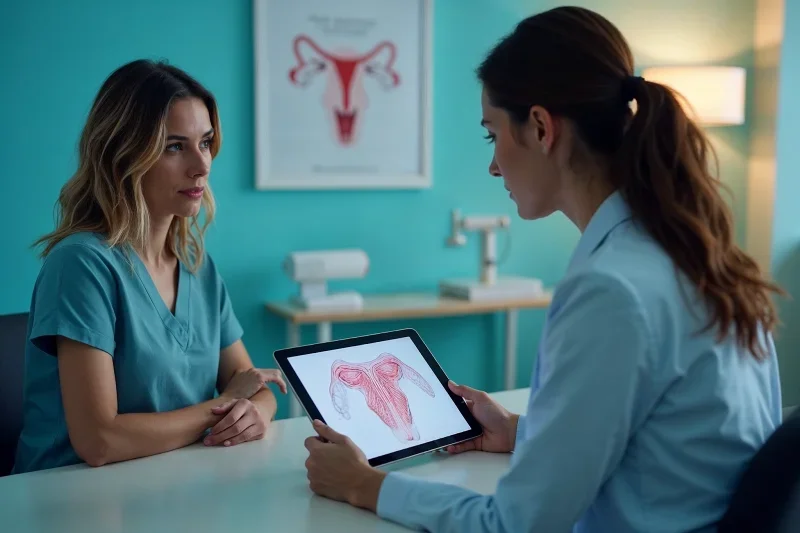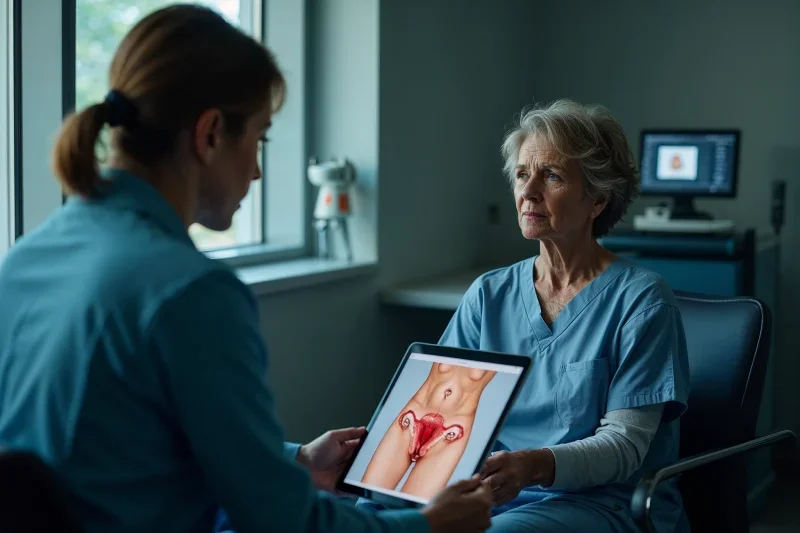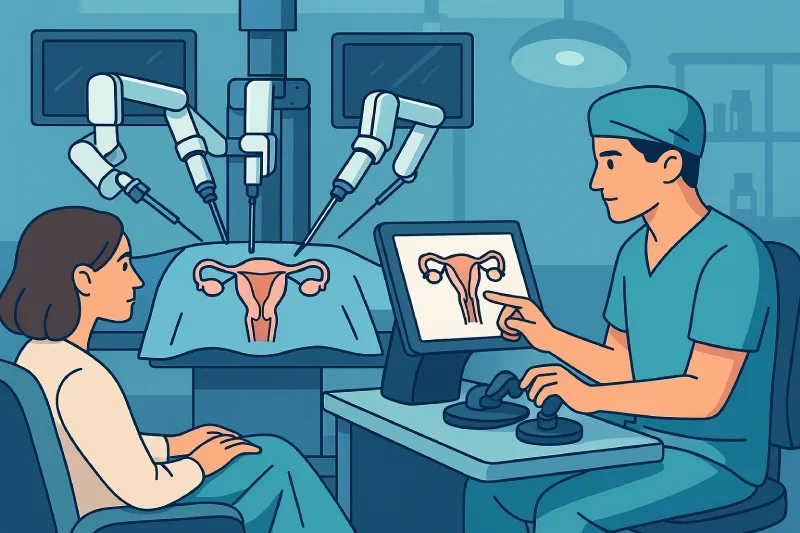Risks and Complications of Robotic Tubal Reversal Surgery
Categories:
By: Ethan Cole
Robotic tubal reversal surgery offers an excellent safety profile with significantly lower risks than traditional open surgery. While no surgical procedure is completely risk-free, the advanced precision of robotic technology has made tubal reversal safer and more predictable than ever before.
Understanding potential complications helps you make informed decisions and recognize what to expect during recovery. Most patients experience smooth healing with minimal complications, and serious adverse events remain rare.
The key advantage of robotic surgery lies in its minimally invasive approach. Smaller incisions, enhanced precision, and reduced tissue trauma translate to faster healing and fewer complications compared to conventional surgical methods.
This guide covers everything you need to know about robotic tubal reversal safety, from common minor risks to rare complications, helping you approach your surgery with confidence and realistic expectations.
Key Takeaways
Robotic surgery significantly reduces risks: Enhanced precision and minimally invasive approach lower complication rates compared to traditional open surgery methods for tubal reversal procedures.
Most complications are minor and manageable: Common risks include minor bleeding, infection, and temporary discomfort, occurring in less than 2% of patients with good outcomes.
Ectopic pregnancy risk ranges 2-7%: While higher than normal pregnancy risk, 93-98% of pregnancies after tubal reversal develop normally in the uterus with proper monitoring.
Anesthesia and positioning are well-managed: Modern protocols and experienced teams safely handle specialized requirements, with complications rare even in higher-risk patients.
Prevention strategies are highly effective: Pre-operative preparation, smoking cessation, weight management, and following post-operative care guidelines dramatically reduce complication risks.
Early recognition prevents serious complications: Knowing warning signs and maintaining follow-up appointments ensures prompt treatment if any issues arise during recovery.
Why Robotic Surgery Offers Enhanced Safety
Robotic technology has revolutionized tubal reversal surgery by providing surgeons with unprecedented precision and control. This advanced approach significantly reduces many risks associated with traditional surgical methods while improving overall patient outcomes.
Precision Benefits of Robotic Technology
Robotic instruments offer 360-degree articulation and tremor elimination, allowing surgeons to perform delicate fallopian tube reconstruction with exceptional accuracy. The high-definition 3D visualization system magnifies the surgical field up to 10 times, enabling precise identification of healthy tissue and optimal reconnection points.
This enhanced precision directly translates to better surgical outcomes. Surgeons can create more precise sutures, minimize unnecessary tissue manipulation, and achieve superior tube reconstruction quality compared to traditional laparoscopic or open approaches.
The robotic system's steady, controlled movements eliminate human hand tremors that can occur during microsurgery. This stability is particularly important when working on the delicate fallopian tube structures that require millimeter-level precision.
Reduced Complication Rates vs Traditional Surgery
Studies consistently show lower complication rates with robotic surgery compared to open surgical approaches. The minimally invasive nature reduces infection risk, blood loss, and trauma to surrounding organs and tissues.
Robotic surgery eliminates the need for large abdominal incisions required in open procedures. This reduction in surgical trauma leads to decreased pain, lower infection rates, and reduced risk of adhesion formation that can complicate future pregnancies.
The improved visualization and precision also reduce the likelihood of inadvertent organ injury. Surgeons can clearly identify and avoid critical structures like blood vessels, bowel, and bladder during the procedure.
Faster Recovery and Less Tissue Damage
Patients typically experience significantly shorter recovery times with robotic surgery. Most women return to normal daily activities within one to two weeks, compared to four to six weeks with traditional open surgery.
The smaller incisions heal faster and leave minimal scarring. This reduced tissue trauma means less post-operative pain and a lower risk of complications during the healing process.
Blood loss during robotic procedures is typically minimal, reducing the need for transfusions and associated risks. The controlled surgical environment allows for better hemostasis and immediate management of any bleeding that occurs.
Why Robotic Surgery Offers Enhanced Safety
Robotic technology has revolutionized tubal reversal surgery by providing surgeons with unprecedented precision and control. This advanced approach significantly reduces many risks associated with traditional surgical methods while improving overall patient outcomes.
Precision Benefits of Robotic Technology
Robotic instruments offer 360-degree articulation and tremor elimination, allowing surgeons to perform delicate fallopian tube reconstruction with exceptional accuracy. The high-definition 3D visualization system magnifies the surgical field up to 10 times, enabling precise identification of healthy tissue and optimal reconnection points.
This enhanced precision directly translates to better surgical outcomes. Surgeons can create more precise sutures, minimize unnecessary tissue manipulation, and achieve superior tube reconstruction quality compared to traditional laparoscopic or open approaches.
The robotic system's steady, controlled movements eliminate human hand tremors that can occur during microsurgery. This stability is particularly important when working on the delicate fallopian tube structures that require millimeter-level precision.
Reduced Complication Rates vs Traditional Surgery
Studies consistently show lower complication rates with robotic surgery compared to open surgical approaches. The minimally invasive nature reduces infection risk, blood loss, and trauma to surrounding organs and tissues.
Robotic surgery eliminates the need for large abdominal incisions required in open procedures. This reduction in surgical trauma leads to decreased pain, lower infection rates, and reduced risk of adhesion formation that can complicate future pregnancies.
The improved visualization and precision also reduce the likelihood of inadvertent organ injury. Surgeons can clearly identify and avoid critical structures like blood vessels, bowel, and bladder during the procedure.
Faster Recovery and Less Tissue Damage
Patients typically experience significantly shorter recovery times with robotic surgery. Most women return to normal daily activities within one to two weeks, compared to four to six weeks with traditional open surgery.
The smaller incisions heal faster and leave minimal scarring. This reduced tissue trauma means less post-operative pain and a lower risk of complications during the healing process.
Blood loss during robotic procedures is typically minimal, reducing the need for transfusions and associated risks. The controlled surgical environment allows for better hemostasis and immediate management of any bleeding that occurs.
Ectopic Pregnancy Risk: Important Facts
Ectopic pregnancy represents the most significant long-term risk following tubal reversal surgery. While the statistics may seem concerning, understanding the context and early detection methods helps you approach this risk with proper perspective and preparation.
Understanding the Statistics (2-7%)
Ectopic pregnancy occurs when a fertilized egg implants outside the uterus, typically in the fallopian tube. After tubal reversal, this risk ranges from 2% to 7% of all pregnancies, which means 93-98% of pregnancies develop normally in the uterus.
|
Pregnancy Type |
Risk After Tubal Reversal |
Risk in General Population |
|
Normal uterine pregnancy |
93-98% |
98-99% |
|
Ectopic pregnancy |
2-7% |
1-2% |
|
Overall pregnancy success |
Varies by age |
N/A |
The increased risk occurs because surgical reconstruction, while successful, may create areas of narrowing or scar tissue that can slow egg transport through the fallopian tube. This delay increases the chance of implantation occurring before the egg reaches the uterus.
The risk varies based on the extent of tube reconstruction required and individual healing responses. Women with minimal tube damage often have risks closer to the 2% range, while those requiring extensive reconstruction may face higher risks.
Early Detection and Prevention
Early pregnancy monitoring is crucial after tubal reversal to detect ectopic pregnancies before they become dangerous. Most ectopic pregnancies are diagnosed between 6-8 weeks of pregnancy through routine blood tests and ultrasounds.
Regular monitoring includes serial beta-hCG blood tests that should double every 48-72 hours in normal pregnancies. Slower rising or plateauing levels may indicate an ectopic pregnancy requiring immediate evaluation.
Early ultrasounds can confirm proper implantation location once pregnancy is detected. Your doctor will schedule these monitoring appointments based on your specific risk factors and symptoms.
Warning signs to watch for include one-sided pelvic pain, vaginal bleeding, shoulder pain, or dizziness during early pregnancy. These symptoms require immediate medical evaluation, as early treatment prevents serious complications.
Most ectopic pregnancies are now detected and treated before rupture occurs, thanks to improved monitoring protocols and patient education about warning signs.
Anesthesia and Positioning Considerations
Robotic tubal reversal requires specific anesthesia protocols and surgical positioning that carry minimal additional risks. Understanding these specialized requirements helps ensure your safety during the procedure.
Anesthesia Safety Measures
Modern anesthesia protocols for robotic surgery prioritize patient safety through comprehensive monitoring and careful drug selection.
Pre-operative evaluation: Thorough assessment of heart, lung, and kidney function before surgery
Continuous monitoring: Heart rate, blood pressure, oxygen levels, and carbon dioxide tracked throughout procedure
Experienced anesthesiologists: Board-certified specialists trained in robotic surgery requirements
Rapid recovery protocols: Medications chosen to minimize post-operative nausea and speed awakening
Emergency preparedness: Full resuscitation equipment and protocols immediately available
Special Considerations for Certain Patients
|
Patient Condition |
Consideration |
Safety Measures |
|
Heart conditions |
Positioning may affect blood flow |
Cardiac monitoring, modified positioning |
|
Lung disease |
Gas insufflation increases pressure |
Respiratory monitoring, pressure adjustments |
|
Obesity |
Positioning challenges |
Specialized equipment, extra padding |
|
Previous abdominal surgery |
Adhesions may complicate procedure |
Extended surgery time, conversion planning |
|
Blood clotting disorders |
Increased bleeding risk |
Pre-operative testing, medication adjustments |
Pre-operative testing, medication adjustments
The steep head-down positioning (Trendelenburg) required for robotic surgery may temporarily affect breathing and circulation. Your anesthesia team monitors these changes closely and adjusts ventilation settings as needed.
Patients with significant heart or lung conditions receive special evaluation before surgery. Your surgical team may recommend alternative approaches or additional monitoring based on your individual health profile.
Most patients tolerate the positioning and anesthesia requirements without complications. The procedure typically lasts 2-3 hours, during which your vital signs remain stable under careful monitoring.
Minimizing Your Risk: Prevention and Care
Taking proactive steps before and after surgery significantly reduces your complication risk and promotes optimal healing. Following these guidelines helps ensure the safest possible experience and best outcomes.
Pre-Surgery Preparation
Proper preparation sets the foundation for successful surgery and smooth recovery.
Complete all pre-operative testing: Blood work, EKG, and other required tests ensure you're ready for surgery
Stop smoking at least 4 weeks before surgery: Smoking dramatically increases infection and healing complications
Maintain healthy weight: Being at optimal weight reduces surgical risks and improves recovery
Discontinue blood-thinning medications: Follow your doctor's instructions about stopping aspirin, ibuprofen, or other medications
Arrange post-operative support: Ensure someone can drive you home and assist during initial recovery
Follow fasting instructions precisely: Eating or drinking before surgery increases anesthesia risks
Shower with antibacterial soap: Use prescribed soap the night before and morning of surgery
Post-Operative Care Guidelines
Careful attention to recovery instructions prevents most complications and promotes optimal healing.
Monitor incision sites daily: Watch for increasing redness, swelling, warmth, or unusual drainage
Take prescribed antibiotics completely: Finish the entire course even if you feel fine
Avoid heavy lifting for 6 weeks: Lifting over 10 pounds can strain healing tissues
Follow activity restrictions: Gradually increase activity as directed, avoid strenuous exercise initially
Attend all follow-up appointments: Regular monitoring catches potential issues early
Report unusual symptoms immediately: Severe pain, fever, heavy bleeding, or difficulty breathing require urgent care
Maintain proper nutrition: Protein-rich diet and adequate hydration support healing
Avoid swimming and baths: Stick to showers until incisions are fully healed
Use prescribed pain medication appropriately: Take as directed to stay comfortable while healing
When to Seek Medical Attention: Warning Signs
Knowing when to contact your healthcare provider ensures prompt treatment of any complications. Most recovery proceeds smoothly, but recognizing concerning symptoms helps you get help when needed.
Immediate Emergency Signs
These symptoms require immediate medical attention or emergency room evaluation. Do not wait or try to manage these symptoms at home.
Severe abdominal pain: Sharp, intense pain that doesn't improve with prescribed pain medication
Heavy bleeding: Soaking more than one pad per hour or passing large blood clots
Signs of infection: Fever over 101°F, chills, or flu-like symptoms
Breathing difficulties: Shortness of breath, chest pain, or rapid breathing
Severe nausea and vomiting: Unable to keep fluids down for more than 8 hours
Fainting or dizziness: Especially when standing or with associated weakness
Leg swelling or pain: Sudden onset of calf pain, swelling, or redness indicating possible blood clot
Concerning Symptoms That Need Evaluation
Contact your surgeon's office within 24 hours if you experience these symptoms. While not immediately life-threatening, they require professional assessment.
Persistent incision problems: Increasing redness, warmth, swelling, or pus drainage from surgical sites
Worsening pain: Pain that increases rather than gradually improves after the first few days
Urinary issues: Difficulty urinating, burning sensation, or blood in urine
Persistent nausea: Ongoing nausea affecting your ability to eat or drink normally
Unusual discharge: Foul-smelling or abnormal vaginal discharge
Sleep disruption: Severe insomnia or restlessness lasting more than 2-3 days
Emotional concerns: Severe anxiety, depression, or mood changes beyond normal post-surgery adjustment
Most patients experience normal healing without these complications. However, early intervention when symptoms do occur prevents minor issues from becoming serious problems and ensures the best possible recovery outcome.
Conclusion
Robotic tubal reversal surgery offers an excellent safety profile with significantly lower risks than traditional surgical approaches. While potential complications exist, the advanced precision of robotic technology has made this procedure safer and more predictable than ever before.
Most patients experience smooth recovery with minimal complications. The key to optimal outcomes lies in choosing an experienced surgeon, following pre-operative preparation guidelines, and adhering to post-operative care instructions.
Understanding potential risks, especially the 2-7% ectopic pregnancy risk, empowers you to make informed decisions and recognize warning signs early. With proper monitoring and care, complications are rare and usually manageable when they do occur.
The benefits of robotic surgery - enhanced precision, faster recovery, and reduced tissue trauma - make it the preferred approach for tubal reversal in appropriate candidates.
Ready to Learn More About Your Safety?
Dr. Jason Neef specializes in robotic tubal reversal surgery and prioritizes patient safety above all else. With extensive experience in minimally invasive procedures, Dr. Neef can discuss your individual risk profile and safety measures specific to your situation.
Schedule a consultation with Dr. Jason Neef to discuss robotic tubal reversal safety and determine if this procedure is right for you.
Schedule Your Robotic Tubal Reversal Consultation
Call (817) 568-8731Categories:
Frequently Asked Questions
-
Yes, robotic tubal reversal surgery is very safe with low complication rates. The minimally invasive approach reduces risks compared to traditional open surgery, with most patients experiencing smooth recovery and excellent outcomes.
-
The most common risks include minor surgical site infection (less than 2%), temporary bloating from surgical gas, mild bleeding, and normal post-operative fatigue. These complications are typically minor and resolve quickly.
-
Serious complications are rare with robotic tubal reversal surgery. Major complications like organ injury or severe bleeding occur in less than 1% of cases due to enhanced surgical precision and visualization.
-
Ectopic pregnancy occurs in 2-7% of pregnancies after tubal reversal surgery. While higher than normal pregnancy risk, this means 93-98% of pregnancies develop normally in the uterus with proper monitoring.
-
Stop smoking 4 weeks before surgery, maintain healthy weight, complete all pre-operative testing, follow post-operative instructions carefully, attend all follow-up appointments, and report any concerning symptoms immediately to your healthcare team.
-
Contact your doctor immediately for severe abdominal pain, fever over 101°F, heavy bleeding, breathing difficulties, or signs of infection. Call within 24 hours for persistent nausea, worsening pain, or unusual discharge.
-
Modern anesthesia for robotic surgery is very safe with comprehensive monitoring throughout the procedure. Serious anesthesia reactions occur in less than 1% of cases, with experienced teams managing any complications effectively.
-
Robotic surgery uses smaller incisions, provides enhanced precision with 3D visualization, reduces tissue trauma, minimizes blood loss, and allows faster recovery, all contributing to significantly lower complication rates than traditional approaches.
-
Your surgical team provides 24/7 support for any complications. Most issues are minor and managed with medication or additional monitoring. Serious complications are rare but handled promptly with appropriate medical intervention.
-
Patients with severe heart or lung conditions, active infections, or certain blood clotting disorders may need special evaluation. Your surgeon will assess your individual health profile to determine if robotic surgery is appropriate.












